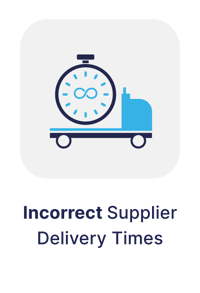- Products
- Use Cases
- Process contractors and validate credentials
- Improve facility compliance to industry standards
- Improve speed of visitor check-in process
- Screen visitors or restrict access to my facility
- Automate my reception experience
- Improve and automate my facility evacuation process
- Manage facility security across multiple locations
- Industries
- Pricing
- Resources
- Company
Measuring Warehouse Performance to Improve Efficiency
January 12, 2023
Operational costs are the biggest expense for warehousing by a large margin. With an average net margin of 3.45% to 10.33% in 2022, the transportation and logistics industry demands innovation to streamline efficiency. An effective warehouse management system has a direct impact on profitability.
Ongoing political unrest, rising energy costs, material shortages, and inflation challenge supply chains even further. Warehouse managers have increasing pressure to improve operational efficiency to maintain margins.
The industry is turning to warehouse visitor management software to overcome these challenges for improved automation and accuracy.

Managers use these tools to measure warehouse efficiency and performance. This article explores expert insights on the most effective methods of measuring efficiency and maximizing profits.
The Importance of Measuring Warehouse Efficiency and Performance
The key to maximizing efficiency is measuring and tracking performance and metrics. Data allows managers to find weaknesses and opportunities to improve and streamline processes. To improve production numbers, warehouses must consider other factors like inventory levels or processing times.
Measuring warehouse efficiency allows for a holistic view of how a business performs, ensuring that all departments work together toward common goals.
Advanced analytics provide valuable insight into specific problem areas that may need further attention. By identifying bottlenecks, warehouse managers make better staffing levels or product mix decisions, ultimately improving throughput and profits.
There are many ways to measure warehouse performance. The crux of each is to use an objective measurement scheme to establish a baseline and evaluate the results of ongoing efforts.
With sophisticated data analysis at your fingertips, you can create a system that accurately reflects your business' in-house strengths and weaknesses while creating a roadmap for future growth.
.webp?width=1800&height=1013&name=Warehouse%20management%20software%20(2).webp)
5 Tips to Measure Performance of Warehouse Operations
Quantifying smooth, efficient, and reliable operations is essential to a successful warehouse. Here are five tips to help you measure performance and achieve successful warehouse operations.
-
Implement Warehouse Technology for Real-Time Data
Leveraging real-time data through cloud-based warehouse software keeps managers agile and informed. These tools improve oversight, making it possible to manage multiple locations from anywhere - even on your smartphone. Always know who is in your building and instantly generate reports with automated record-keeping.
Tracking warehouse visitors and entries offers valuable data for improving productivity and helps ease compliance with industry standards. A visitor management platform is essential to maximize the reporting, control, and flow of people in your building.
Warehouse inventory is also best managed through technology. Use software to track how much product is available and when SKUs are arriving and shipping to best decide where to allocate resources and stock items.
This information also helps you avoid potential shortages or excesses, which can significantly impact sales and customer service.
-
Identify Gaps in Warehouse Performance
Large and scaling warehouses have complex operations, especially when operating as 3PLs. Complexity can lead to gaps in performance that may compromise productivity and profitability. As such, managers must work to uncover these gaps.
Common trouble areas include
|
|

|
|
|

|
Use warehouse employee performance metrics and a data-driven approach to pinpoint issues and correct them before they become bigger problems.
-
Keep Track of Safety Performance
Safety performance is critical to employee health and safety. It also reduces costly shutdowns and delays from accidents.
One way to track warehouse safety performance is through a safety audit. A safety audit is a systematic review of an organization's safety management system to identify deficiencies. The audit determines the organization's overall performance concerning safety awareness, risk assessment, and incident response.
Businesses need a system that tracks safety performance to identify areas to improve. This ensures that the company remains safe and productive while meeting customer expectations.
-
Streamline Your Receiving Process
Packages, parcels, and deliveries piling up just won't do. Warehouses are designed for storage, but they also require organization to avoid clutter and loss and ensure items go to whom they're intended.
An important aspect of streamlining the receiving process is automating warehouse paperwork. Although manual processes are common solutions for clarity or traceability purposes, they are slow and leave room for error. Contactless delivery tracking software streamlines receiving end-to-end from package arrival to pick up.
Effective warehouse delivery management uses automated mailroom management software. When a package arrives, it is scanned with a smartphone, automatically creating a record including important details:
- Date
- Time
- Recipient
- Code
The system can send automatic delivery notifications letting the recipient know their package has arrived. If the package is not picked up, regular reminders are automatically sent to prevent packages from sitting around or piling up. As a result, there is less clutter and fewer lost or forgotten deliveries.
Streamlining your receiving process reduces the time and cost associated with receiving goods. Track and manage all your deliveries at a glance with DeliveryOS.
-
Set a Plan to Execute Process Improvements
The planning and execution of process improvements within a warehouse environment presents a challenge, especially where there are large volumes and variety of items. It is important to have a systematic approach to achieve the desired results.
One way to improve performance is to set goals and objectives for each process step, then track progress toward reaching those goals.
Use measured data to identify areas where improvement is necessary. Once corrections are in place, ensure they are implemented systematically throughout the warehouse and measured to review results.
Ongoing implementation and monitoring of improvements keeps warehouses operating at peak efficiency.

Where to Start?
Creating a more productive warehouse by measuring efficiency sounds simple, but it takes significant effort and know-how. Fortunately, the right warehouse management software and strategies ease the process.
Read on for some of the most effective methods to measure efficiency and warehouse performance.
-
Establish Warehouse Goals
Companies rely on distribution centers and warehouses in almost every supply chain, so improving warehouse efficiency is a top priority. Despite the challenges of measuring warehouse performance, there are a few practical approaches you can take to get started.
First, establish warehouse goals to guide how the organization wants its warehouses to function. After all, you can only improve performance if you know what needs to be improved. Warehouse managers should also develop employee performance metrics to track progress in meeting these goals.
With this information readily available, it is easier to identify problems and make necessary adjustments. Clearly defined expectations support optimizing operations and ensure that your warehouse remains on target as priorities change.
Work with your logistics team and monitor warehouse efficiency trends to create a success-forward environment.
-
Outline Key Performance Indicators (KPIs)
Set up your warehouse to achieve maximum efficiency and performance by tracking KPIs. Common key performance indicators warehouse managers use to measure progress include inventory levels, worker productivity, visitor registration, and safety statistics.
Each of these indicators has a different purpose and provides valuable insight into various aspects of warehouse management. By carefully selecting the right set of KPIs to measure, businesses will quickly and easily identify areas where they need to make changes to improve overall efficiency.
-
Perform Regular Audits
Implementing or overhauling a warehouse audit can be a daunting task. Still, knowing how to measure performance and make informed decisions about how best to run the business is essential. Regular audits determine whether the warehouse is operating at optimal levels and identify areas for improvement.
Audits are necessary to ensure that goals are being met and benchmarks are reached. By tracking warehouse performance metrics over time, you will identify any changes in process or pattern that may need attention.
-
Improve Efficiency and Productivity with Warehouse Management Software
Warehouse management is a complex process that can become streamlined and powerful by choosing the best warehouse management system.
Streamline your process and improve productivity with iLobby's FacilityOS. This facility management platform integrates into many processes throughout the warehouse to optimize and digitize safety, security, and compliance protocols in complex enterprises, such as managing visitors in manufacturing and industrial environments. With FacilityOS, you'll have everything you need to manage your workload more effectively and keep your facilities safe.
Request a demo today and meet the enterprise facility and visitor management platform trusted by over 1,000 companies and deployed at 6,000+ locations around the world. Simplify facility management with FacilityOS from iLobby.




